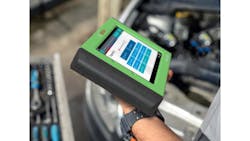Today’s shops require not just one, but multiple scan tools for a typical day’s work. As more and more electronics are incorporated in vehicle systems, the more challenging it is for technicians to find the problem and fix the vehicle fully. From simple maintenance procedures such as identifying codes and performing resets to advanced programming and ADAS calibrations, the use of scan tools is not only recommended but essential in this day and age.
“If you want to fix a vehicle, you need to connect to the electronics on it to figure out how they are wired,” says Bruno Gattamorta, vice president of sales and marketing at Cojali USA.
Chad Schnitz, national sales manager – strategic accounts, Autel North America, adds that systems in late-model vehicles are communicating with each other at extremely high speeds and these systems can see a problem coming even before the driver knows there is an issue.
“Having a high-quality, professional-level scan tool gives the shop the ability to talk to that vehicle and see what the vehicle systems see,” he says. “Vehicle systems are so intertwined that they can actually cover up issues that we cannot see or feel.”
As a mobile tool dealer, you don’t have to know everything about every scan tool. Listening to your customers’ needs and having a basic understanding of the functions, capabilities, and coverage will go a long way and, ultimately, make the sale.
Finding the best fit
There are many scan tools on the market today and therefore many to select from. Each scan tool manufacturer claims to have their own specialty, better vehicle coverage, more diagnostic functions and features, etc. These claims can be overwhelming for a technician who needs to figure out what tool is best for them to purchase.
“Some may think just because it’s the most expensive, it’s the best – and that’s not always the case,” Autel’s Schnitz says. “Unfortunately, there is no one tool that can do everything.”
The best way for mobile dealers to help find the right scan tool for their customer is by talking to them to determine their individual and shop-based needs. Asking questions - perhaps a lot of questions - to discover what they need now and, in the years, to come is key.
“Spend time with your customers, listen to their needs, and identify what options they have, focusing on what would really benefit their shop in the short and long term,” says Dario Peruch, managing director at TEXA USA.
Some sample questions, Schnitz offers, include: Do you want TPMS built into your diagnostic tablet? Do you want the ability to do J2534? Do you need the option to program keys?
A challenge that many technicians face when selecting a scan tool is finding one with the ideal coverage. Making sure the scan tool covers most, if not all, of their customers’ vehicles (makes, models, and years) entering their shop is a top concern.
“Mobile dealers can help technicians identify what [scan] tools have the best coverage by visiting the manufacturers’ website,” says Oksana Kravets, marketing and creative agency specialist at Bosch Automotive Service Solutions.
Bosch offers an online coverage map that’s updated when a new software update has been published. “Technicians can use this coverage map to look at specific vehicles that are common in their shops to see the coverage that they can expect from a Bosch scan tool,” Oksana says.
As with most other tools, being able to hold the tool and see how it works is crucial for technicians. Demonstrating a scan tool is no different and is not difficult to do.
“In most cases, you simply need to show the customer how to navigate the user interface and where to find the key functions,” says Jeremy Hyde, product manager at Cornwell Quality Tools. “If you can show them a couple short cuts or useful features along the way, you are a hero.”
Often, mobile dealers will lend a demo scan tool to a technician for a short period of time. If the technician has a question, the manufacturer is able to assist, whether by remoting in or by offering online resources.
“If a [technician] requires assistance we can remote into that scan tool and walk them through the process of how it works and where the test functions are that they need,” says Tao Shichun, sales manager of international market center at Launch Tech.
Cojali is one of the many companies that have been making the shift towards online training, enabling technicians to view the full functionality of the scan tool on their own clock. The company offers videos on specific features on their YouTube channel, as well as webinars with actual calibrations and real-world examples.
Bosch also offers online videos and content to help train technicians on the most prominent features of their scan tools.
Up and coming features
As technology on vehicles advances, so do scan tool features. One key feature is the integration of traditional diagnostics and technical information.
“Technicians appreciate additional information like wiring diagrams, troubleshooting, and procedures,” TEXA’s Peruch says. “This focus towards quality and completeness is a key factor and an important trend. Remote diagnostics, OTA capabilities, and ADAS systems are a hot topic; it’s a completely new market that will grow even bigger [over] the next years.”
Cojali’s Gattamorta agrees that as the complexity of vehicle systems become more advanced, having only the diagnostics part is not enough. “A lot of [technicians] may know what the specific part looks like or where it is at, so the technical information is becoming more and more of the driver of the diagnostics platforms and the functionality of the shop,” he says. “Not just reading codes.”
Topology and direct CAN bus scanning are additional features new to the aftermarket. Topology provides a technician a map of the vehicle's network.
“From the initial all-systems scan, the technician can see how the modules are connected and how the systems communicate with each other,” Schnitz says. “Not only are we now able to see all the modules and codes present, we can see the communication lines between those modules to see the health of the network as well.”
As for direct CAN bus scanning, some advanced scan tools now have a lab scope built into the vehicle communication interface (VCI), enabling them to perform scope analysis on a network with the already connected OBD-II connector, Schnitz adds.
For shops servicing highway trucks, school buses, and light commercial trucks, Cojali recently launched its Jaltest Commercial Vehicles Diagnostics Kit that has a feature allowing users to copy ECM configurations onto their computer and then take that same configuration and put it onto a new ECM. Cojali’s Gattamorta notes that being able to copy the parameters has been a huge benefit for many customers that previously had to go directly to the dealer.
Another noteworthy feature that has been recently introduced to scan tools is the ability to program keys.
“More and more systems in vehicles are being tied to security,” Schnitz says. “If a module is replaced, the key may have to be re-synchronized or reprogrammed to the vehicle. Having a tool in the shop that can read keys and program keys to vehicles [is] becoming an everyday need in some shops.”
Autel’s IM508 can be used in conjunction with the shop’s scan tool to program keys, whereas the IM608 combines the diagnostics and key programming into one unit.
Scan tool selling success
For Cornwell tool dealer John Patterson Jr., selling scan tools has become second nature. For the past 13 years, Patterson has been selling tools with his route located in Baltimore, Maryland. His stops mainly consist of independent and specialty shops, with some body shops and dealerships mixed in.
His success may have streamlined from his previous career working as a technician for 20 years, the last ten years of which he specialized in diagnostics. However, as Patterson contributes his success to taking the time to learn each scan tool and familiarize himself with the menu. That way when it comes time to demo the unit to a customer, he can do it in less time – about 10 minutes.
This tactic has worked well for him over the years starting with Autel’s MaxiDas DS708. With the help of shop owners talking amongst themselves, Patterson said he soon found himself providing numerous demonstrations which lead to “an avalanche of sales.”
Today, the biggest thing for Patterson is “staying informed by keeping up-to-date in the industry and having healthy connections - not just with your flag but also your suppliers.”
For Patterson, when it comes to keeping up with new and upcoming scan tool technology, he turns to his customers. Many will ask him if he saw this technology or that, or if he sees a customer with a scan tool that he doesn’t recognize, he’ll ask them about it.
He also stays connected with manufacturers’ technical service workers. For example, he became good friends with one of Autel’s technical service workers and will email him once a day, if not more, for customer assistance, to learn about a product, or to get his thoughts on a new product.
When selling scan tools, Patterson would advise fellow mobile tool dealers to talk to the customer to find out what is going to work best for him or her.
“Listen to the questions that your customers ask and use that as key points to focus on,” he says. “You can start anywhere from selling a $50 to $60 code reader and work your way up to a $6,000 or $7,000 scan tool just based on what the customer’s needs are.”
Demonstrating a scan tool, as well as loaning one out to a shop or technician, can prove very beneficial, especially to make the sale. Technicians are eager to get their hands on a new tool and to see the capabilities it has to offer.
“I’m a big believer in doing all my demos in the shop,” Patterson notes. “For one, it’s an environment they are familiar with and it’s a real-world demo. Some scan tools have demonstration modes that you can pull stuff up on the screen and do it on the truck. I prefer to hook it up to a car and put the tool in the customer’s hand and then navigate through it with them.”
In many instances, the customer may teach him a thing or two, he adds. “You can always learn something else and your customer base is your best source for information.”
“There’s a reason why God gave you two ears and one mouth,” Patterson laughs.
About the Author
Kayla Nadler
Associate Editor | Vehicle Repair Group
Kayla (Oschmann) Nadler was previously an associate editor for the Vehicle Repair Group.
With an education in journalism and public relations, Nadler contributed to Professional Tool & Equipment News (PTEN) and Professional Distributor magazines, as well as VehicleServicePros.com.


